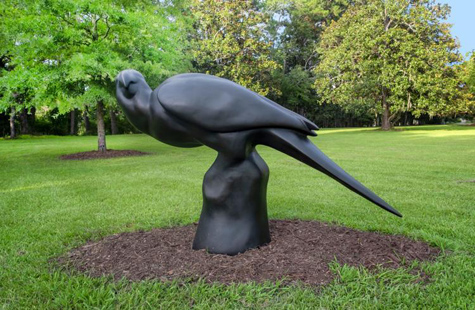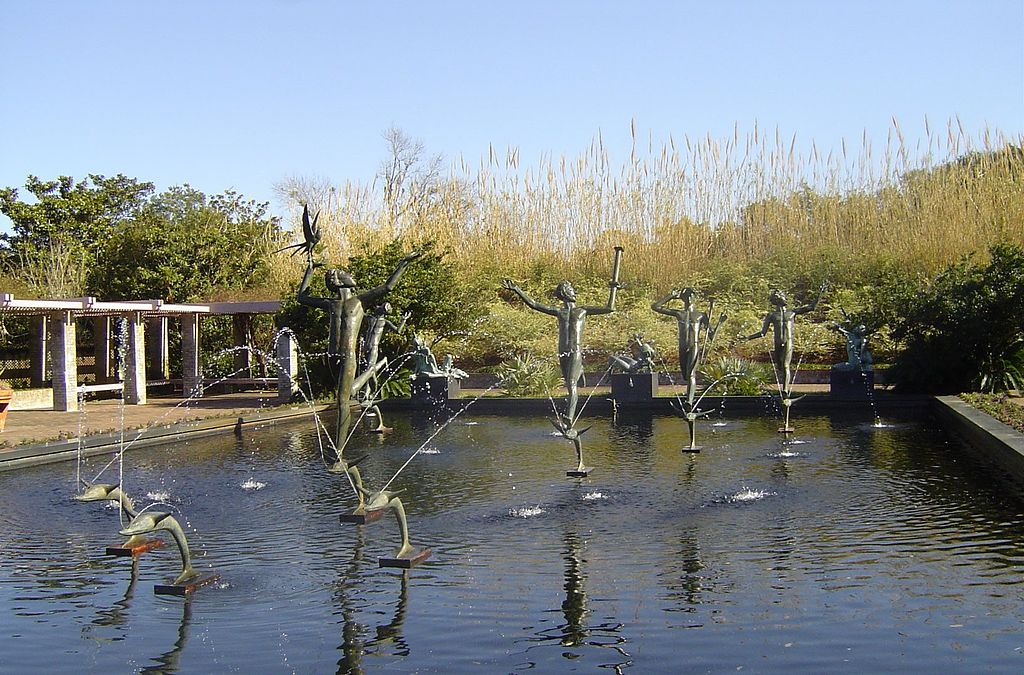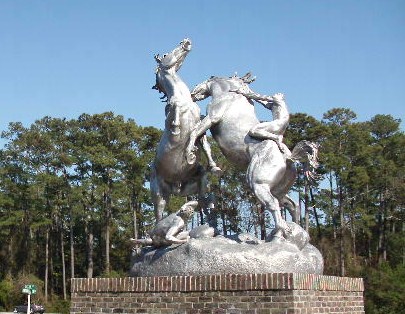The Bronze Works of Brookgreen Gardens
Rising in the stirrups, sword plunged into the sky, Joan of Arc embodies female power. The bronze sculpture of the medieval girl soldier and savior of France glimmers in the twilight at Brookgreen Gardens.
 Carolina Parakeet by artist Todd McGrain.
Carolina Parakeet by artist Todd McGrain. Photograph courtesy of Brookgreen Gardens.
Sculpted by Anna Hyatt Huntington in all her military armor and glory, Joan of Arc is a notable bronze sculpture on the sprawling, 9,127-acre national treasure, located between Murrell Inlet and Pawley’s Island, South Carolina.
Visitors wander among 250-year-old live oaks draped in Spanish moss at Brookgreen Gardens, which includes not only a 550-acre sculpture garden that exhibits almost 1,500 small-scale figurative works by more than 350 artists, but also a zoo, botanical garden, trails and archaeological sites. Founded in 1931 by Huntington and her philanthropist husband, Archer Milton Huntington, Brookgreen Gardens has earned a place as a National Historic Landmark.
The family-friendly Lowcountry attraction is so vast that people need several days to see it all, said Brookgreen Gardens CEO and President Page Kiniry.
It’s an informal experience, where children are free to run down the sidewalk, she said. There are no “do not touch” signs.
“Being outdoors in a garden really opens up the experience,” Kiniry says. “The way the light strikes the sculpture at different times of day can make it look different."
 Fountain of the Muses by Carl Milles.
Fountain of the Muses by Carl Milles. Photograph courtesy of Wikipedia.
Brookgreen was the first public sculpture garden in the United States featuring American realistic sculpture. The property’s live oaks were planted in the early 1700s on what was then four rice plantations. Brookgreen’s sculpture garden has 560 sculptures by 245 artists, including Richard McDermott Miller.
“He is considered one of the greats of the 20th Century,” Kiniry says. “He donated some of his bronzes to us. They are spectacular.”
Miller (1922-2004) was known as The Figure Sculptor of SoHo, and modeled figures directly from life in wax or clay to be cast in bronze. Wind on the Water is a good example of Miller’s sense of movement. The Saint James Triad, which shows nudes lounging within frames, exudes sensuality. Saturday Night and Olga Sitting are other favorites.
Bronze allows the sculptor to capture that fleeting sense of movement best because no detail is lost in the lost wax casting process. Nowhere is this conveyed more realistically than in the 6-foot-tall Carolina Parakeet, centerpiece of The Lost Bird Project, on exhibit in Brookgreen Gardens’ Arboretum and the Bleifeld Gallery.
“The Lost Wax tradition is the main method still employed today by modern foundries in casting bronze,” said Bryan Rapp, director of the Master Sculpture Program at Brookgreen. “Some of the technologies and equipment are different, but the basic process of melting bronze and pouring into molds is the same,” he said.
Artist Todd McGrain created the bronze sculptures of extinct birds, including great auk, Labrador duck, passenger pigeon, and the Carolina Parakeet, Kiniry said.
While the birds within the exhibit are smaller, traveling versions of the extinct species of birds, Brookgreen is exhibiting the full-size Carolina Parakeet through Nov. 3.
Declared extinct in 1939, it’s the only parrot species native to the southeastern United States.
Each bronze sculpture is permanently installed at the last place the bird was seen, Kiniry said.
Along with the installation in the Arboretum, the Bleifeld Gallery is displaying smaller bronze castings of the five sculptures plus drawings and photographs related to the project.
Brookgreen cares about plants, animals and cultural history of the region, and The Lost Bird Project helps people understand the urgency of the modern issues.
“The art is a way of stimulating conversation,” she says.
Brookgreen is hosting McGrain for a lecture on The Lost Bird Project on Nov. 2, Kiniry said.
Elsewhere at Brookgreen, indoor galleries, such as those in the Rainey Sculpture Pavilion, feature smaller sculptures, including some bronzes.
For Kiniry, one bronze sculpture stands out for its elegant lines and Art Deco appeal.
 Fighting Stallions, statue by Anna Hyatt Huntington.
Fighting Stallions, statue by Anna Hyatt Huntington. Photograph courtesy of Wikipedia.
“I really love Anna Huntington’s work, Diana of the Chase,” Kiniry says. “It’s an incredibly elegant piece, with a beautiful pool in the center and a dog at her feet,” she said. “And, it’s created by a woman.”
As Brookgreen’s website describes the sculpture: “The goddess stands on a globe, gazing upward, the bow raised in the left hand, the right hand drawn back after releasing the string. Her hair is in short curls. A piece of drapery falls from her right arm around her body. A hound leaps upward between her feet.”
In 1912, Huntington was one of the highest-paid professional women in the United States. Her works could be found at the Metropolitan Museum of Art and the National Academy. She and Archer married in 1923, when she was 47 and he was 53. She lived to be 97.
“She was creating art at a time when it was very rare for women,” Kiniry says.
Today, Hyatt Huntington’s sculptures can be seen around the world -- El Cid in Spain, and a duplicate of Joan of Arc in a quiet enclave of Manhattan, New York.
Speaking of quiet, visitors can browse Brookgreen’s unique open storage and research facility.
“We work really hard to have 90 percent of our pieces on view,” Kiniry said.
Bronze is an ideal medium to convey movement, feeling and energy.
“Bronze has a certain permanence to it,” Rapp said. “It’s extremely durable and will last thousands of years. When cast into human and animal forms for monuments and public art, it becomes a prosthesis for storytelling that transcends time and space, connecting us with both the past and the future.”
Resources:
Brookgreen Gardens, 1931 Brookgreen Garden Dr., Murrells Inlet, SC, (843) 235-6000
Also in this Issue:
- The Pilgrim: A Bronze Beacon for Philadelphia
- Browne Designs: Forged in Flame and Copper
- Typothecary: Continuing the Art of Copper Letterpressing
- The Bronze Works of Brookgreen Gardens
- Rare Calder Brass Earrings Sold at Lark Mason Auction
